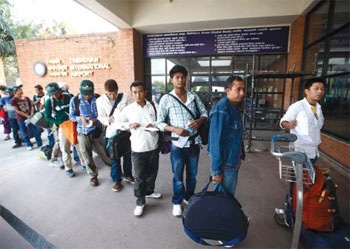Migrant Labor: A Central Pillar of Nepal’s Grim Economy

Note to readers: please click the share buttons above
They appear a hapless collection of desperate village lads lured by false promises, making their way to a hostile place fraught with peril. A small but significant number perish while working abroad, shipped home in a stark wooden box. Yet millions of Nepal’s youths take the imponderable risks. They remain away four or more years, subjected to severe climate conditions, often misled about their assignments and salaries, dismissed for minor infractions. Yet their numbers swell year-after-year, with remittances back to their families mounting correspondingly.
After almost two decades of accelerating numbers feeding this global labor market and the growing dependence on cash remittances home, up to 44% of Nepal’s GDP derives from young citizens’ flight abroad.
Is this trend inevitable? And who really benefits?
Inevitable, if a) merchants in Nepal’s cities continue to reap benefits by renting lodgings and supplying goods and food for a lopsided consumer economy generated and sustained by migrants’ remittances, and b) the home government continues to disregard chronic joblessness, avoiding a genuine commitment to develop industries and enhance agriculture. That’s what’s needed for real growth and jobs at home.
Given the poor economic prospects for the vast majority of Nepalis and their disenchantment with a new democracy where parties dish out generous grants to friends, one needs to ask if Nepal’s government itself may be exploiting foreign labor demand to keep citizens’ energies directed elsewhere.
The lure of jobs overseas is irresistible for Nepal’s able young men and women. They leave wives, parents and children; many with jobs at home relinquish them; students abandon schooling and take on debt — all to become one of the daily 1,200+ migrants who board a plane for the Arab Gulf or Malyasia. (A 2015 Nepali Times report notes 2,500 arrive or leave daily)
Ganesh is one of them. He set off on his Dasain holiday to the village four years ago, but never returned– not to his part time job in Kathmandu, not to continue his schooling, not to free lodging at his cousin-auntie’s house.
“He’d stayed with us since class two; he was a good student with only a year left to complete class 10. Had there been a family crisis”, she recalled, “I’d have known.”
Her suspicion that Ganesh had gone to the Arab Gulf was confirmed after six months. His sister Didi visited Auntie-Ma’m to collect Ganesh’s bedding. She herself had left their village for Kathmandu with her baby and Ganesh’s mother.
“They rent a room here in the city; she says life is easier now; there was no one to work their fields and anyway they can live in Kathmandu on what her husband and Ganesh send them.”
Didi’s husband was in Qatar too.
“Every Nepali family has someone in The Emirates, Qatar, Saudi, Malaysia” sighs Aunti Ma’m. “Here in Nepal, we can’t find carpenters to repair our building; no helpers in the kitchen; no boys to serve in the local cafes; a shortage of motor mechanics.”
Ganesh is one of more than 4.5 million –some estimate 7 million, if migrants to India are included — Nepali youths working in the inhospitable atmosphere of Arab Gulf states. They choose hazards abroad over farming their terraced hillsides, over whatever a middle class family may pay them as gardeners, cleaners or drivers, over the ten dollars a day they can earn (in season) as a porter hauling trekkers’ supplies through the mountains.
This exodus of healthy young men and women from Nepal increased sharply twenty years ago when Malaysia and Arab Gulf states were recruiting unskilled laborers. At home, the situation looked unpromising, with Nepal entering a period of instability; the Maoist revolution was spreading through the countryside; development projects produced insufficient jobs and anti-monarchy protests were widening.
Overseas work for low wages seems to be the best option for millions of workers in a country with no industrial development and where farmers produce barely enough to meet household needs. In the 1980s, young people left villages to work in an expanding Tibetan carpet industry in Kathmandu Valley. Factory managers were unconcerned if workers were as young as 12, if they had no education and if they slept on the floor near their looms. Eventually, exploitative conditions and heavy use of child labor in the industry drew international ire. A human rights campaign on behalf of underage workers essentially shut down the carpet factories; tens of thousands became jobless. Labor brokers supplying workers for the expanding Arab Gulfmarket tapped that void and, year-by-year, the number of Nepalis working there rose.
Seeking work outside is not new to Nepal. A 2005 overview notes how, more than a century ago, Nepalis migrated to India to work in tea plantations. Starting in the 19th Century village men were recruited into British Gurkha military regiments, their numbers increasing through the two world wars. (Today, Gurkhas serve in the Indian army and with British regiments posted in Afghanistan as well.)
Returned workers with substantial capital from their overseas work happily share evidence of improvements to their lives, changes otherwise impossible. Take Ram, for example; he set up a small factory in Nepal with his earnings. Gyelmi Lama boasts:
“As a driver in Qatar, I earned 150,000 Nepali rupees ($1,500) monthly; nowadays I’m with my family in Kathmandu, and I support my parents in our village in Hetara.”
He’s one of countless taxi drivers in Kathmandu Valley returned from overseas, now owning their own vehicles. Chetri was returning to Dubai where he runs a shop, mainly serving Nepali clients. KP, another outgoing passenger, manages a Nepali restaurant in Abu Dhabi catering to migrant workers, and tells me of his plans for a travel agency specializing in tours for Europeans living in the Emirates; “It’s barely four hours away; they can visit Kathmandu for a weekend!”
Remittances sent monthly sustain workers’ families back home. (One survey indicates that by 2009, average annual income of Nepali households from remittances reached the equivalent of $1,400 and $2,100.) This allows villagers to hire a poorer relative to mind a few animals in their village, rent lodging for themselves in the city, and send children to a private school. (Government schools are so bad that even inexpensive private schools are preferred, and these too are flourishing because of remittances.) Purna who worked in Saudi Arabia spent 8,000 rupees ($80.) monthly for his daughter’s school fees. Since she’s heading to college, he has new plans for himself;
“I keep my two taxis, but I stop driving; too much construction going on now; I make partner in a new business in Kavre near my village. We buy a bulldozer and make contracts to build roads.” Yes,” he asserts, “lots of business opportunity now.”
What percentage of returned migrant workers can duplicate Purna’s, Gyelmi’s and Chetri’s endeavors is hard to calculate.
Image below: cover of the author’s book, Heir to A Silent Song: Two Rebel Women of Nepal (click to order)

Human rights investigations and early reports of migrants’ conditions in the Nepali press highlighted the human toll—extortion, fraud and abuse were widespread. (Anti-Muslim feeling in Nepal has been fueled by early reports of workers’ mistreatment by Arab employers.) Investigative journalist Devendra Bhattarai writing for Kantipur,and filmmaker Kesang Tseten drew attention to migrants’ troubles in 2010. And while improved conditions curbed severe exploitation, many migrants still suffer. Laborers’ hardships are compounded by the inability or refusal of Nepali embassies abroad to intervene on behalf of distressed citizens, or to assist them. (When one ambassador called Qatar an open jail, she was recalled.)
Only recently has the Nepali press been willing to more closely examine the context of labor migration. The result is a sobering account of exploitation by labor brokers, mainly Indian and Nepali, beginning before workers reach their destination. (Nepali Times, 2015) Some bilateral agreements to protect workers have been negotiated and a $50. million fund in Nepal (hardly used to date) was set up for needy cases.
Notwithstanding all the obstacles and difficulties, at the apex of those responsible sits the Nepali government. This is addressed, finally, in an excellent 2018 Nepali Times series that points to the administration’s policy failures, and exposes how officials enrich themselves off fees and bribes from would-be migrants. It asserts what others have avoided saying:– the government is evading the need to rectify unemployment at home. “…Successive elected rulers since 1990 have masked their failure to create jobs within the country by taking the easy way out– to export labour.”
*
Aziz is a veteran anthropologist and radio journalist, also author of Heir to A Silent Song: Two Rebel Women of Nepal, published by Tribhuvan University, Nepal, and available through Barnes and Noble in the USA. She is a frequent contributor to Global Research and Asia-Pacific Research.


